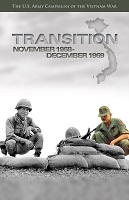U.S. Army Campaigns of the Vietnam War

TRANSITION, NOVEMBER 1968–DECEMPER 1969
Adrian G. Trass
U.S. Army Campaigns of the Vietnam War
CMH Pub 76-6, Paper
2018; 76 pages, illustrations, maps, further readings
GPO S/N: 008-029-00628-6
The U.S. Army Center of Military History recently published a new pamphlet in its U.S. Army Campaigns of the Vietnam War series, Transition, November 1968–December 1969, by Adrian G. Traas. The author discusses the gradual reduction of the U.S. Army's involvement in Vietnam that began after Richard M. Nixon was elected president in November 1968. Even as U.S. and South Vietnamese forces battled an increasingly-elusive enemy, Army officials stepped up efforts to create a South Vietnamese military strong enough to defend their nation with only minimal support from American troops. In the spring of 1969, President Nixon announced his plan for the phased withdrawal of U.S. forces from South Vietnam, a policy quickly dubbed "Vietnamization." As the American public's support for the war continued to erode, U.S. military leaders spent the remainder of 1969 preparing for further troop reductions and the inevitable turnover of bases and equipment to South Vietnamese forces.
* View this publication online